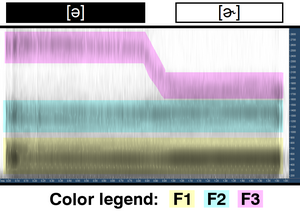This article possibly contains original research. (November 2023) |
An r-colored or rhotic vowel (also called a retroflex vowel, vocalic r, or a rhotacized vowel) is a vowel that is modified in a way that results in a lowering in frequency of the third formant.[1] R-colored vowels can be articulated in various ways: the tip or blade of the tongue may be turned up during at least part of the articulation of the vowel (a retroflex articulation) or the back of the tongue may be bunched. In addition, the vocal tract may often be constricted in the region of the epiglottis.[1]
| R-colored vowel | |||
|---|---|---|---|
| ◌˞ | |||
| ɚ | |||
| ɝ | |||
| ɹ̩ | |||
| ɻ̍ | |||
| IPA number | 327 | ||
| Audio sample | |||
| Encoding | |||
| Entity (decimal) | ˞ | ||
| Unicode (hex) | U+02DE | ||
| X-SAMPA | @` | ||
| |||

R-colored vowels are exceedingly rare, occurring in less than one percent of all languages.[1] However, they occur in two of the most widely spoken languages: North American English and Mandarin Chinese. In North American English, they are found in words such as dollar, butter, third, color, and nurse. They also occur in Canadian French, some varieties of Portuguese,[2][3][4] some Jutlandic dialects of Danish, and in a few indigenous languages of the Americas and of Asia, including Serrano and Yurok in the United States, Luobohe Miao in China, and Badaga in India.
Notation
editIn the IPA, an r-colored vowel is indicated by a hook diacritic ⟨ ˞ ⟩ placed to the right of the regular symbol for the vowel. For example, the IPA symbol for schwa is ⟨ə⟩, while the IPA symbol for an r-colored schwa is ⟨ɚ⟩. Similarly, the IPA symbol for the open-mid central unrounded vowel is ⟨ɜ⟩, while an r-colored open-mid central unrounded vowel is ⟨ɝ⟩. This diacritic is the hook of ⟨ɚ⟩ or ⟨ɝ⟩, symbols constructed by John Samuel Kenyon along with ⟨ᶔ⟩ by adding the retroflex hook (right hook) to ⟨ə⟩ and ⟨ɜ⟩.[5] Both ⟨ɚ⟩ and ⟨ɝ⟩ were proposed as IPA symbols by the editors of American Speech in 1939 to distinguish it from [əɹ].[6]
The IPA adopted several ways to transcribe r-colored vowels in its 1947 chart: the turned r ⟨ɹ⟩; the superscript turned r ⟨əʴ⟩, ⟨aʴ⟩, ⟨eʴ⟩, ⟨ɔʴ⟩, etc.; the retroflex hook ⟨ᶕ⟩, ⟨ᶏ⟩, ⟨ᶒ⟩, ⟨ᶗ⟩, etc.;[7] and added ⟨ɚ⟩ as a variant of ⟨ᶕ⟩ in its 1951 chart.[8] In 1976 the retroflex hook was dropped due to insufficient usage.[9] In 1989, at the Kiel Convention, the hook of ⟨ɚ⟩ and ⟨ɝ⟩ was adopted as a diacritic placed on the right side of the vowel symbol for r-colored vowels, e.g. ⟨ɛ˞ o˞ ɔ˞⟩.[10] Following the convention of alternating ⟨ɜ⟩ and ⟨ə⟩ for non-rhotic accents, ⟨ɝ⟩ and ⟨ɚ⟩ signify stressed and unstressed, respectively, rather than a difference in phonetic quality.[11] The use of the superscript turned r (əʴ) is still commonly seen.
Examples
editEnglish
editR-colored vowels are found in most rhotic forms of English, including General American and Irish English. The r-colored vowels of General American can be written with "vowel-r" diacritic:[12]
- [ɚ]: hearse, assert, mirth (stressed, conventionally written [ɝ]); standard, dinner, Lincolnshire (unstressed)
- [ɑ˞]: start, car
- [ɔ˞]: north, war
In words such as start, many speakers have r-coloring only in the coda of the vowel, rather than as a simultaneous articulation modifying the whole duration. This can be represented in IPA by using a succession of two symbols such as [ɑɚ] or [ɑɹ], rather than the unitary symbol [ɑ˞].[12]
Singing
editIn European classical singing, dropping or weakening of r-colored vowels has been nearly universal and is a standard part of classical vocal training. However, there have always been other singing styles in which r-colored vowels are given their full emphasis, including traditional Irish singing styles and those of many performers of country music.[citation needed] Certain post-grunge singers made heavy use of this technique to such an extent that many people derisively exaggerated this tendency when referencing their music. In certain particular cases, a vowel + /r/ is pronounced instead as two syllables: a non-rhotic vowel followed by a syllabic /r/.[citation needed]
Mandarin Chinese
editIn Mandarin, the rhotacized ending of some words is the prime way by which to distinguish speakers of Standard Northern Mandarin (Beijing Mandarin) and Southwestern Mandarin from those of other forms of Mandarin in China. Mandarin speakers call this phenomenon erhua. In many words, the -r suffix (simplified Chinese: 儿; traditional Chinese: 兒) is added to indicate some meaning changes. If the word ends in a velar nasal (ng), the final consonant is lost and the vowel becomes nasalized.[13] Major cities that have this form of rhotacized ending include Beijing, Tianjin, Tangshan, Shenyang, Changchun, Jilin, Harbin, and Qiqihar. This erhua has since spread to other provincial capitals not home to Standard Mandarin, such as Shijiazhuang, Jinan, Xi'an, Chongqing, and Chengdu.
In rhotic accents of Standard Mandarin, such as those from Beijing, Tianjin, most of the Hebei province (e.g. Tangshan, Baoding, Chengde), eastern Inner Mongolia (e.g. Chifeng, Hailar), and in the Northeast, vocalic r occurs as a diminutive marker of nouns (pinyin: ér) and the perfective aspect particle (了; le). This also occurs in the middle syllables of compound words consisting of three or more syllables. For example, the name of the famous restaurant Go Believe (狗不理) in Tianjin is pronounced as 'Gourbli' (Gǒu(r)bùlǐ → Gǒurblǐ). The name of the street Dazhalan (大栅栏) in Beijing is pronounced as 'Da-shi-lar' (Dàshànlàn(r) → Dàshílàr).
Quebec French
editIn Quebec French, the vowel /œ̃/ is generally pronounced [œ̃˞] and the r-colored vowels are also pronounced in loan words.[citation needed] For example, the word hamburger can be pronounced [ambɚɡɚ], the word soccer can be pronounced [sɒkɚ] etc.
The vowel /ø/ may be pronounced as [ø˞ː] in open syllables.
Other examples
editIn the 1930s the Dravidian language Badaga had two degrees of rhoticity among all five of its vowels, but few speakers maintain the distinction today, and then only in one or two vowels. An example is non-rhotic [be] "mouth", slightly rhotacized ("half retroflexed") [be˞] "bangle", and fully rhotacized ("fully retroflexed") [be˞˞] "crop".[14]
The Algic language Yurok illustrated rhotic vowel harmony. The non-high vowels /a/, /e/ and /o/ could become /ɚ/ in a word that has /ɚ/. For example, the root /nahks-/ 'three' became /nɚhks-/ in the word /nɚhksɚʔɚjɬ/ 'three (animals or birds)'.[15]
Luobohe Miao also contains [ɚ].[16]
See also
edit- Linking R
- Rhotic consonant (r-like)
- Syllabic consonant
References
edit- ^ a b c Peter Ladefoged; Ian Maddieson (1996). The sounds of the world's languages. Wiley-Blackwell. p. 313. ISBN 0-631-19815-6. Archived from the original on 2016-05-10. Retrieved 2016-09-24.
- ^ (in Portuguese) Acoustic-phonetic characteristics of the Brazilian Portuguese's retroflex /r/: data from respondents in Pato Branco, Paraná Archived 2016-03-03 at the Wayback Machine. Irineu da Silva Ferraz. Pages 19–21
- ^ (in Portuguese) Syllable coda /r/ in the "capital" of the Paulista hinterland: sociolinguistic analysis Archived 2013-09-26 at the Wayback Machine. Cândida Mara Britto LEITE. Page 111 (page 2 in the attached PDF)
- ^ (in Portuguese) Callou, Dinah. Leite, Yonne. "Iniciação à Fonética e à Fonologia". Jorge Zahar Editora 2001, p. 24
- ^ John Samuel Kenyon (1935). American pronunciation: a textbook of phonetics for students of English. G. Wahr. p. 191. Archived from the original on 2021-08-16. Retrieved 2020-03-16.
- ^ "A Petition". American Speech. 14 (3). Duke University Press: 206–208. October 1939. doi:10.2307/451421. JSTOR 451421.
- ^ Association phonétique internationale (1947). "The International Phonetic Alphabet (revised to 1947)". Le Maître Phonétique. Troisième série. 25 (88). Supplement. JSTOR 44748304.
- ^ Association phonétique internationale (1952). "The International Phonetic Alphabet (revised to 1951)". Le Maître Phonétique. Troisième série. 30 (97). Front matter. JSTOR 44748475.
- ^ Wells, John C. (1976). "The Association's Alphabet". Journal of the International Phonetic Association. 6 (1): 2–3. doi:10.1017/S0025100300001420. S2CID 249403800.
- ^ International Phonetic Association (1989). "Report on the 1989 Kiel Convention". Journal of the International Phonetic Association. 19 (1): 67–80. doi:10.1017/S0025100300003868. S2CID 249412330.
- ^ Wells, John C. (1982). Accents of English. Vol. 1: An Introduction (pp. i–xx, 1–278). Cambridge University Press. p. 121. ISBN 0-52129719-2.
- ^ a b John Ellery Clark; Colin Yallop; Janet Fletcher (2007). An introduction to phonetics and phonology (third ed.). Malden, MA: Blackwell. p. 66. ISBN 978-1-4051-3083-7. Archived from the original on 2016-06-10. Retrieved 2016-09-24.
- ^ Duanmu, San (2007). The phonology of Standard Chinese (2nd ed.). Oxford: Oxford University Press. pp. 212–224.
- ^ http://www.phonetics.ucla.edu/appendix/languages/badaga/badaga.html Archived 2021-02-11 at the Wayback Machine
- ^ "Yurok – Survey of California and Other Indian Languages". linguistics.berkeley.edu. Archived from the original on 2013-03-01. Retrieved 2013-02-12.
- ^ "Luobohe Miao language". Omniglot.com. Archived from the original on 2017-11-26. Retrieved 2017-11-23.
Further reading
edit- L. F. Aungst; J. V. Frick (1964). "Auditory discrimination ability and consistency of articulation of /r/". Journal of Speech and Hearing Research. 29: 76–85. doi:10.1044/jshd.2901.76. PMID 14122671.
- J. F. Curtis; J. C. Hardy (1959). "A phonetic study of misarticulation of /r/". Journal of Speech and Hearing Research. 2 (3): 244–257. doi:10.1044/jshr.0203.244.
- Christine Ristuccia (2002-09-30). "Phonologic strategy for /r/ remediation". Advance for Speech-Language Pathologists and Audiologists. 12 (39): 21. Archived from the original on 2009-02-10. Retrieved 2018-12-26.
- C. L. Ristuccia; D. W. Gilbert; J. E. Ristuccia (2005). The Entire World of R Book of Elicitation Techniques. Tybee Island, GA. ISBN 0-9760490-7-4.
{{cite book}}:|work=ignored (help)CS1 maint: location missing publisher (link)

